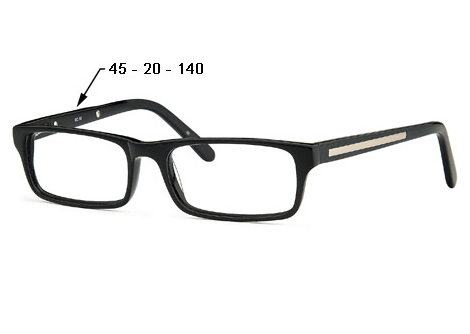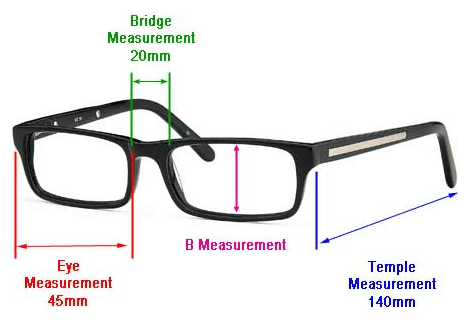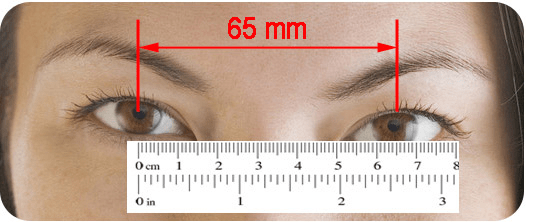Buying Glasses Online
All frames are available with clear prescription lenses, as prescription sunglasses, or as non-prescription sunglasses. You have the option of selecting your lens types, lens materials, tint colors, Polarized® lens colors, light adjusted (Transitions® , DriveWear®) lens colors, and anti reflective coatings. Our optic lab will craft your lenses to your prescription and lens options.
Frame Size


The easiest way to find your frame sizes is to look at the frames you already own.
Most manufactures write the frame size on the inside of the temple.
For example, frame size: 45-20-140
PD – Pupillary Distance

Pupillary Distance (PD) is the distance between the centers of the pupils in each eye measured in millimeters. This measurement is used when preparing to make prescription eyeglasses. Positioning lenses correctly in relation to the center of the pupils is especially important for higher powered lenses due to the location of the optical center of the lenses.
Obtaining Your PD
1. From Your Optometrist
Before you have your eyes examined, ask your Optometrist to provide you with your PD measurement. Note, the PD measurement is technically not part of your prescription, but a measurement for the purpose of creating eyeglass lenses, so you may be charged a small fee.
Most PDs are a single value and is entered into the form as a “Distance PD”. Under certain circumstances, your Optometrist may give you two PD’s, one for each eye. This is called Monocular Distance PD and the measurement is taken from the bridge of the nose to the center of each pupil. In this case you would have a PD for the Right Eye and a PD for the Left Eye. Enter each value into the form for as indicated for “Two PDs”.
2. Measure Your PD Yourself.
To measure your pupillary distance (PD), you can follow these steps:
- Gather the Tools: You will need a millimeter ruler or a PD ruler, which is specifically designed for measuring PD.
- Stand in Front of a Mirror: Position yourself in front of a mirror, as this will make the process easier.
- Place the Ruler: Hold the ruler horizontally against your forehead, right above your eyebrows. Ensure it’s straight and level.
- Close One Eye: Keep one eye open while measuring the PD for the other eye. This helps in focusing on one eye at a time.
- Align with Pupils: Look straight into the mirror and align the ‘0’ mark on the ruler with the center of one of your pupils.
- Measure: While keeping the ruler in place, use the millimeter side to measure the distance to the center of your other pupil. Make sure you measure to the exact center of the pupil.
- Record the Measurement: The number you get is your pupillary distance. Typically, it will be in millimeters. Repeat the process a couple of times to ensure accuracy.
It’s essential to measure your PD accurately, especially if you’re ordering prescription glasses or contact lenses online. If you have any doubts or difficulties in measuring your PD, consider having it measured by an eye care professional during an eye exam. They can provide the most precise measurement for your specific needs.
3. Taking a picture for your pupillary distance (PD)
Link: Taking a picture for PD
How To Read Your Prescription
Sorry Coming Soon
